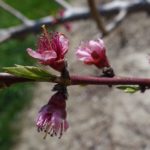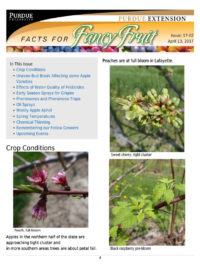Uneven bud break is affecting some of the apple varieties at Meigs (Fig. 1). This is usually associated with apples that grow in areas with mild winters, like the one we just had. Apple trees in warmer climates often demonstrate uneven bud breaking and bloom times. With some trees exhibiting everything from silver tip to[Read More…]
As the spray season approaches, it is good to remember the profound impact water quality has on the performance of pesticides used by fruit growers. Purdue Pesticides Program recently published a guide, The Impact of Water Quality on Pesticide Performance PPP-86, available at the Education Store, 1-888-EXT-INFO or www.extension.purdue.edu/store/. I highly recommend this guide to[Read More…]
The 2017 growing season has officially started as vines are budding out. As we go through the next couple of weeks, it is important to realize that some potential pest and disease problems require early season sprays. The first is Phomopsis, a major problem on many grape varieties in the Midwest. Mancozeb should be applied[Read More…]
One way insects communicate with individuals of the same species is with pheromones. Pheromones are volatile chemicals released by an insect that usually can be detected only by individuals of the same species. There are a number of different types of pheromones, but the most common type is the sex pheromone. Usually the females will[Read More…]
One of the first and most important parts of a good insect and mite management program is the application of an early season oil spray to control European red mites, San Jose scale, and several species of aphids. Scales overwinter on the tree as nymphs and European red mites and aphids overwinter as eggs. Because[Read More…]
A number of growers have experienced increasing problems with woolly apple aphids over the last several seasons. Part of the reason for the increased populations may be related to the changing spectrum of insecticides you are using to control other pests. Our experience has been that many of the aphicides that are available that provide[Read More…]
Although we started off the spring extremely early, an extended cool period has delayed crop development, reduce risk of frost, and made many growers feel a lot more comfortable. As can be seen from Figure 1, we are still tracking early in terms of growing degree days, but not as early as 2012. We are[Read More…]
We’re getting close to the time when growers need to make chemical thinning decisions – for many the most perplexing and risky decision they will make all year. This is usually a tricky call to make, even more so when we have had spring frosts. Luckily in most places the spring frosts have not been[Read More…]
The last few weeks has been a dark time for our industry. We have lost some of the stalwarts of the fruit and vegetable industries. We remember: George A. Adrian, 95, Indianapolis Thomas E. Roney, 70, Greenfield Gene M. Wild, 90, Zionsville John Hilger, Ft. Wayne Abner J. Horrall, 85, Bicknell While these folks came[Read More…]
Purdue University prohibits discrimination against any member of the University community on the basis of race, religion, color, sex, age, national origin or ancestry, genetic information, marital status, parental status, sexual orientation, gender identity and expression, disability, or status as a veteran. This material may be available in alternative formats. 1-888-EXT-INFO Disclaimer: Reference to products in this publication is not intended to be an endorsement to the exclusion of others which may have similar uses. Any person using products listed in this publication assumes full responsibility for their use in accordance with current directions of the manufacturer.




